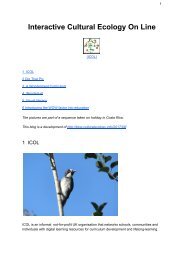scopeofzoology
You also want an ePaper? Increase the reach of your titles
YUMPU automatically turns print PDFs into web optimized ePapers that Google loves.
together broadly distinguish the different kinds of animals from each other. Early zoologists<br />
dealt only with the description of shapes. It was not until the second and third decades of this<br />
century that they turned to the description of sequences of movement, or the 'behavioural<br />
structures' of animals. It can be argued that zoology has distinction as a subject only when<br />
dealing with the building of three-dimensional shapes, and the assembly of patterns of<br />
movement. That is to say, what is distinctly animal is found only in the evolution of<br />
communities of cells to form organ systems and the establishment of behavioural structures<br />
by which animals interact with each other and with their environment. The motivation of<br />
zoologists is summarised by the questions "What is the use in having a particular shape and<br />
mode of behaviour? Does it contribute to the animal's success? If so, How?" and "What<br />
makes it happen?"<br />
Questions on the origins of shape and size are still central to modern zoology. The most<br />
original approach to escape the anatomist's method of comparing shapes piecemeal was to<br />
view all changes in relative dimensions simply as the topical expressions of some<br />
comprehensive and pervasive change of shape through development taking place mainly in<br />
one direction. At the turn of the century, D'Arcy Thompson developed this approach to grasp<br />
evolutionary transformations as a whole, viewing the change of shape as analogous to that<br />
produced by distorting a sheet of rubber on which has been drawn a house or a face. Every<br />
single aspect of the drawing changes but the transformation as a whole might be defined by<br />
some quite simple formula describing the way the rubber had been stretched. Thompson's<br />
methods were later developed by J.S. Huxley into more usable quantitative relationships<br />
between the rate of reproduction of one part of the organism to another. This quantification of<br />
8




